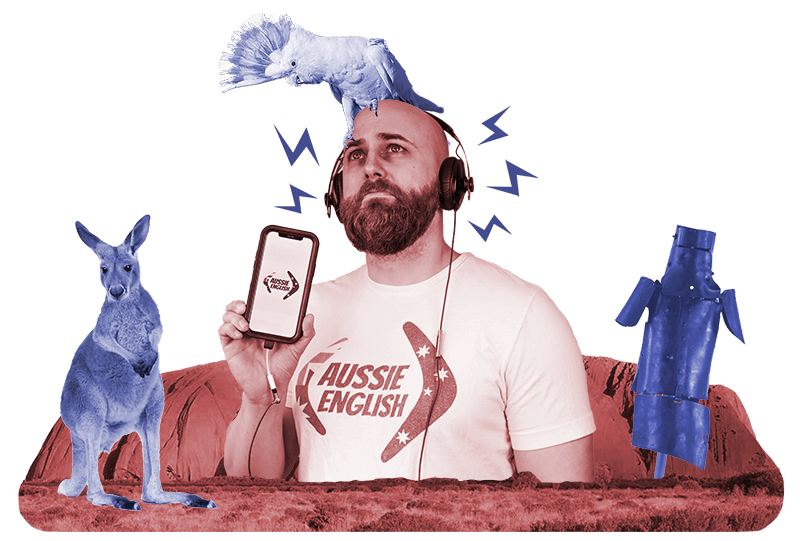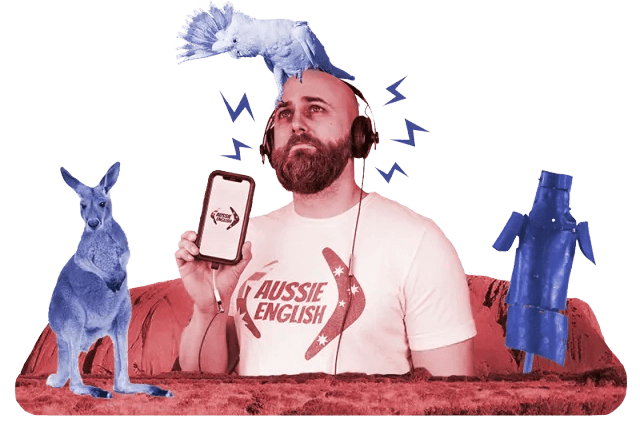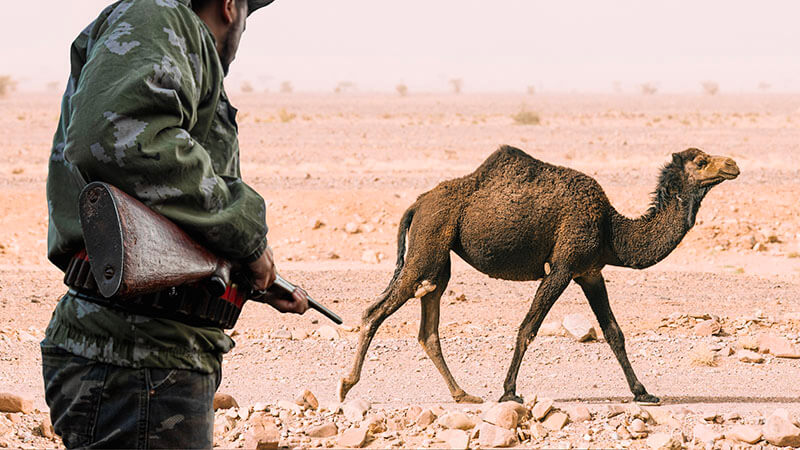
AE 1095 - INTERVIEW
Digging into Palaeontology and Fossils with Dr Matthew McCurry
Learn Australian English in each of these episodes of the Aussie English Podcast.
In these Aussie English Interview episodes, I get to chin-wag with different people in and out of Australia!

In today's episode...
Here’s an exciting interview episode for you, guys!
Meet Dr. Matthew McCurry, an Australian palaeontologist and one of my best mates during my PhD.
He and his team at the Australian Museum learned about a farmer who found an impressive fossil that dates back millions of years!
Join us as we discuss why the team initially kept the discovery site a secret and why the fossils found at McGrath Flats are so precious.
Is there anything you want to ask me? Drop in your questions here: https://aussieenglish.com.au/askpete
** Want to wear the kookaburra shirt? **
Get yours here at https://aussieenglish.com.au/shirt
Improve your listening skills today – listen, play, & pause this episode – and start speaking like a native English speaker!

Watch & listen to the convo!
Listen to today's episode!
This is the FREE podcast player. You can fast-forward and rewind easily as well as slow down or speed up the audio to suit your level.
If you’d like to use the Premium Podcast Player as well as get the downloadable transcripts, audio files, and videos for episodes, you can get instant access by joining the Premium Podcast membership here.
Listen to today's episode!
Use the Premium Podcast Player below to listen and read at the same time.
You can fast-forward and rewind easily as well as slow down or speed up the audio to suit your level.
Transcript of AE 1095 - Interview: Digging into Palaeontology and Fossils with Dr Matthew McCurry
G'day, you mob. Welcome to this episode of Aussie English. Today, I have a very special episode for you where I get to chat to one of my mates from back in my PhD days, Dr Matthew McCurry. Now Dr Matthew McCurry, is currently a curator at the Australian Museum, he did his Bachelor of Science in Biology at the University of Newcastle and then a Doctor of Philosophy, his PhD, through Monash in evolutionary biology and Anatomy.
So, he is a curator of palaeontology, which means he works with fossils, an absolutely fascinating subject. So, today I got him on the podcast to talk about his recent discovery with him and his team from the Australian Museum at McGrath's Flat in the New South Wales-Central Tablelands.
So, they effectively stumbled across a really, really impressive fossil deposit from the Miocene period in Australia, which dates back to 23 million years ago. I think this deposit is dated to about 10 to 15 million years. The reason it is so impressive, you'll find out in the interview.
We chat about his findings here, how he became a palaeontologist, why it's such an interesting area of study, why it's important and then also different processes of fossilisation. What is a fossil? What are the different kinds of fossils out there? How do they occur? Everything like that. So, it's a really, really fascinating interview with him. Thank you so much, Matthew, for coming on. Let's get into it.
G'day, you mob. Welcome to this episode of Aussie English. Today, I have dear friend Dr Matthew McCurry, who I did my PhD with at Museum Victoria, and he quickly sort of climbed the ranks and straight off the bat got an amazing position as curator of palaeontology at the Australian Museum. So, Matt, welcome to the podcast.
Hey, Pete.
So, you've been doing the rounds. Obviously, you know, we've been in touch on and off for the last few years, usually in the form of me seeing something crazy in terms of palaeontology and sending it to you and you being like, yeah, I know.
But you did the rounds recently with this really amazing discovery. Do you want to tell us a little bit about that? And then we can get into some more sort of generic palaeontological questions and talk about fossilisation a bit.
Yeah, sure. So, yeah, we've just published a paper on a new fossil site. So, it's the first kind of documentation of this fossil site in New South Wales here in Australia, and it's an amazing fossil site for a couple of reasons.
So, firstly, it preserves really, really high-quality fossils. So, we have things like soft tissues preserving at this fossil site, something you don't normally get, you know, when you when you look at fossil sites here in Australia or around the world.
And when you say soft tissue, you mean like flesh, right? Or feathers and skin and that sort of thing?
Yeah, exactly. We have, for instance, like skin of the fish preserved, we have a fossil feather. And even better, these fossils preserved really, really fine details. So, if we look at them under a microscope, maybe a scanning electron microscope, we can see, even like individual cell walls preserved in these fossils.
Which is pretty astounding, right? Usually, I mean, we can get into this a bit later. But the fossilisation process is usually incredibly rare for any individual organism in the past to have been fossilised, it's, you know, one in a million, one in a billion kind of chance.
And then for intact- What would you say? Specimens to actually survive, let alone their soft tissues and cellular structure, is something really rare because, what, the organisms normally disturb during that process or the process that takes place doesn't preserve certain components of that organism.
Yeah, exactly. So, fossils are rare to begin with. But then when we go out and find a fossil as a palaeontologist, normally we're looking at kind of these fragmentary bits of bone or bits of teeth. They're kind of only the hard parts of the organism normally. And yeah, only normally kind of like broken up bits as well. And so, in this circumstance, we've got the whole organism and we've got all the soft tissue still attached.
Yeah, that's crazy. So, what happened? You want to tell us? This is out at McGrath's Flat; this is the place in the Central Tablelands of New South Wales that you guys apparently stumbled across or a farmer stumbled across.
Do you want to tell us this story about that? Because I love- Having gone through, you know, doing my PhD and everything with a lot of you palaeontologists, you would always hear these stories about, oh yeah, there was just this one random guy who picked up a rock and all of a sudden we had this amazing site and everyone went there and discovered all these crazy things. That seems to happen so often.
Yeah, it does. So, I mean, we rely on people that spend a lot of their time kind of looking around in specific areas to find these fossil sites initially. So, I think the credit for the discovery really goes to the farmer who was ploughing a field and he hit a really hard, heavy rock. And so, he had to get out of his tractor to kind of move it off to the side.
And as he was moving it off to the side, he realised there were fossil leaves in the rock. And we'd met Nigel in that area before, and we were currently excavating a fossil site in another area close to Gulgong. And so, he came up to tell us that, you know, the fossil leaves had been found and we went to check it out in more detail.
And so, since then, we've spent about three years excavating these sites. So, we've kept it secret, and we've just carefully been kind of excavating away at this site and unearthing some really amazing fossils.
What's the importance of sort of keeping it under wraps whilst you guys are going through this process? And how do you decide when to reveal the location and your findings?
Yeah so, we never really reveal the exact location, but...
For obvious reasons, right? People would go in and scavenge it all, and the museums and science wouldn't necessarily have access to the best specimens.
Yeah. And it's particularly important for this fossil site because it is quite small. It's only kind of a really small geographic area, and it'd be quite easy for it to be destroyed. And so, we're worried about people going and kind of collecting fossils for themselves and mining out the area and maybe not recording all the information that goes with it and kind of losing all of that context that we need to be able to interpret this fossil site.
And so, yeah, we try and keep it under wraps, we don't reveal the exact location. But eventually we have to kind of tell everyone about our findings because I mean, the point of doing all this work is that we learn from it and we kind of document what these ecosystems were like in the past. And so, that's kind of the stage we're up to at the moment.
Do you ever have like an ethical or moral dilemma with how much to take away from the site and how much to leave there? Like, I hadn't really thought about that until now, but when I was working at the museum and we would obviously go into to collect specimens of a certain species from a particular area, obviously you don't want to go through and just blitzkrieg the place and kill everything and take it back.
Because, you know, you've destroyed what was there anyway, so there's no point in then recording it, really. But you need to also think I need specimens to obviously be there in the future for future people to come back and have a look at, especially with living species.
Is it the same sort of thing with palaeontology when you guys are excavating sites were you thinking, okay, we have a certain set of methods and tools and everything for pulling fossils out now, but perhaps in the future there'll be better ones for doing that and you need to be like, we need to leave a certain amount here just in case?
Yeah, that's exactly it. And it's a really hard question. So, we always try and leave, you know, a part of the fossil bed intact and in place because we don't know what techniques are going to be available in the future to study it.
But it's always weighing that off against kind of what we really need to know about these ecosystems now and the risk to those places, you know, in the future. So, for instance, if there was a roadway, you know, being constructed over the top of the area, we would be excavating the whole site just to be able to get all the information we can at the moment.
Yeah, because it's going to be disrupted or at least prevented from you having access to it for the long-term future.
Yeah, exactly. Yeah.
So, what did you end up finding out about life in this area from the work that you did? You know, why was this important scientifically? And it got so much coverage, I saw it in the New York Times, I obviously saw you on ABC News, and I was like, I recognise this guy, you know, pay attention. I was like, wow, this story is crazy. So, what were the really- Why was this site so different from the norm and what did you learn from it?
Yeah. So, I think it's a combination of that really high-quality preservation, but also a gap in time that we really need to know more about. And so, during the Miocene, Australia was becoming far more arid to when a lot of our kind of modern-day arid ecosystems are starting to develop.
And kind of the plants that we see as quintessentially Australian, so things like the eucalypts that now cover the continent are starting to evolve as well. So, the ecosystem's going through this massive change in rainfall patterns, and as a result of that change, we're seeing a shift from these rainforests, like miocene rainforest ecosystems that rely on a lot of water into more dry habitats.
And what we know that that change was occurring based on the pollen record, we've never really been able to look into these ecosystems before. We've always just had a lot of questions about what they were like. And so, this is one of our first really good opportunities to study these ecosystems, to find out which species were living in them, what they looked like and how those species were interacting.
So, the quality of preservation at the fossil site really allows us to do that. So, we have, you know, this huge array of fossils preserved, including insects and spiders that we wouldn't normally have preserved at fossil sites.
But we also have some evidence of interactions between species, which is extremely rare in the fossil record. So, for instance, some of these insect fossils have pollen preserved on their bodies, and so we can tell which species of plants they're pollinating in these ancient ecosystems.
And so, obviously, not just that they have the pollen on there, but the pollen was of such good quality at the cellular level in terms of fossilisation that you could zoom in and see what species of plant that pollen came from, right?
Yeah, exactly.
Wow.
And then likewise, we have evidence of stomach contents in some of the species. So, for instance, the fish have stomachs preserved with all of the food that they've been eating, so we can tell, you know, they're preying on certain species of dragonflies and other aquatic insects. And we have good evidence of parasitism, too.
So, we have like, for instance, these freshwater mussels that attach to fish. We've got some of those preserved on the bodies of the fish that we find at the site, and so we can tell which species of parasite are infecting or affecting certain host species as well.
I didn't realise that you could have parasitic mussels, so they, what, just attach themselves to the side of the fish or in their gills or something or?
Yeah. So, these are- They're mussels that live in freshwater kind of riverine ecosystems, and they've developed this really unique way to get around the ecosystem. So, as kind of young individuals, they'll attach themselves to fish and hitch a ride like up and down the river, and they use that to kind of disperse throughout that ecosystem.
And while they're on there, they kind of feed on the slime that covers the fish, and then eventually drop off as an adult. And so, yeah, they've got this really unique ecological characteristic that they hitch a ride on fish around.
Yeah, that's sort of like barnacles on the side of a whale or something, right?
Yeah, exactly. Yeah.
So, what happens? You know, you have this farmer obviously ploughing his fields, he smashes a rock and by chance, he happens to be someone that you've interacted with before and obviously has an inherent interest in palaeontology or fossils or could at least recognise one.
Because I can imagine, what is he, probably one in a thousand in terms of how many people come across these kinds of sites where there would otherwise be a fossil, but they don't give it a second thought, they don't look at it, they don't know what they're looking at and they just kick it aside.
But anyway, you had the luck of this guy knowing what he was looking at was important. What's the process that you guys go through after he reports something like that to you, to all the way through, to obviously publishing something, you know, in a scientific paper?
Yeah, so I guess the first thing we normally ask is to have some fossils, send some photos of the fossils, and so they'll either send us fossils to the museum or they'll take some photos for us to assess. And then based on those images or the fossils that they send in, we decide whether we go out to the site and do a kind of, you know, one day visit to assess the quality of the fossil site.
And then from there, we can decide whether it's worth putting the money and the time, the effort into doing a proper excavation at the site. And so, there's kind of a bit of an assessment period about, you know, deciding where to spend most of our time and money.
And then when you actually get to the site, how do you sort of decide where and where to begin, right? Because I can imagine showing up and there just being a lot of rocks or you having to dig up and there being, you know, a rock bed or something that you have to then get into.
Do you just have at it or is there a sort of sophisticated plan of we need to start from this area, move to here, you know? Obviously, I have no idea how this is done, and I find it fascinating. Yeah.
Yeah. So, a lot of the time, the first way that we would assess the site when we get there is to look at the surface outcrop. So, we walk around with a hammer and chisel or a geological pick, and we kind of assess the surface rock, we see...
Start breaking stuff.
Yeah, start breaking stuff, you know, very carefully. But we're also looking at the types of rocks. So, we're trying to get a feel for, you know, how everything's bedded, how everything's laid out. So, sometimes these areas can be quite complex geologically, there can be, you know, different layers of rock of different types. And all that information kind of feeds into our map in our mind of where we should be looking.
From there, we might start to dig some small pits to see whether the outcrop is, see where the type of rock that we're most interested is. And then from there we can start doing a proper excavation. So, that might involve mapping the area with a drone to get a really high-resolution map of the area. Might involve using some surveying equipment to map everything out as well.
And then from there, we can start, you know, carefully digging and excavating and looking at what's contained inside these types of rock.
And it looks like it was quite a painstaking- You know, you said it took three years, but there were some images of you guys all sort of huddled around what looked like to the layman a, you know, a pile of rocks, rubble with your pickaxes and other tools opening the rocks up.
So, there's actually quite a laborious part to this that most people may not understand that you actually do sit around effectively cracking rocks open to try and find the fossils, right. They're not just sitting there on the surface of these stones, and you just walk around picking them up.
Yeah, look, there can be weeks and years' worth of work that goes into actually finding the fossils within the deposit as well. And so, we're lucky at this one because the fossil site contains so many fossils. So, every time you crack open a rock, you might see three or four...
Wow.
...Fossils on the surface. That almost never happens at a fossil site. But just to kind of paint a picture, so the rock unit is this 50 centimetre or 80-centimetre-thick band of goethite. And it's like iron, so when you hit it with a hammer, it actually dings.
Really?
Yeah. And so, you look at the side of the rock and it's really finely bedded, so you can see lines all running in one direction. And so, you use a hammer and chisel to try and break the rock along one of those lines.
So, it's like when you would chop wood or something you want to go with the grain as opposed to against it.
Yeah. And so, all of the fossils are compressed within those layers, and so you really want to try and get a neat split across that layer. But it can be quite difficult, so, you know, you're hitting something that's essentially iron with a hammer and chisel. And so, there's a fair amount of kind of manual labour that goes into trying to get these to split really nicely across that scene.
How- If you were to have, say, a foot by a foot cube of this bed material, this rock material, when I think of a fossil being in the rock, I guess as again, as a layman, I'm thinking of this three-dimensional animal that is just effectively within the rock. But in reality, how compressed, you know, say vertically is that animal? Because it's- the fossil itself is actually quite thin, I imagine.
Yeah. So, it really depends on the fossil site. But this fossil site, they're very compressed. So, there's been a flow of basalt over the top of the deposit, and it's put a lot of pressure kind of crushing everything down into these thin layers. And so, you've only got a couple of millimetres of relief across the surface of the fossil, and so we're essentially looking at them in 2-D.
So, when you say relief, you mean how much it projects above the surface that it's sitting on?
Yeah.
Wow. So, that must be difficult, too, then. Because if you have, you know, say, a certain amount of width or thickness, you have to sort of determine how much do you actually want to open up. Because it could be an infinite number of layers that you effectively could get out, but it becomes more and more brittle, and...
Yeah. There's always a risk of breaking things that you've already found. So, when you split open the rock, it's kind of like a book and you get to look across the surface and see all the different fossils. Then you have to decide whether you're going to try and re-split that rock again or whether the fossils that you've found are actually the ones that you really want to keep.
So, it's almost like opening a book, but you get to open it once and you get to read whatever page you open. And it's kind of like, oh, there's all these other potential pages, but in trying to open and get to those pages, I'm going to potentially destroy what I've just opened up.
Yeah, exactly.
Far out. So, can you paint a picture for us about what this site would have looked like at the time that these animals were obviously alive, and then perishing and falling into whatever the deposit was, to then go on to become fossilised?
Yeah, yeah, definitely.
So, we know that it's a billabong, so an Oxbow lake, they call it in some areas around the world. And so, it's a small kind of pond off the side of a river. So, as the river was weaving through this rainforest ecosystem, it managed to cut through and leave an isolated kind of still pond off to the side.
And so, this small still water body was sitting in a rain forest ecosystem, we can tell it was a rain forest based on all the different types of plants that we have preserved at the fossil site.
So, we have lots of ferns, we have lots of nothofagus, which is kind of a tree known as a southern beech today, relative of that species. And it's quite an enclosed kind of wet Miocene environment. Then if we look at the pollen within the deposit, which can blow from further away, there are some drier habitats close by...
That's really cool, right? The fact that you can look at the pollen and get an idea, not of just what was at that specific site and what fell into the say, the billabong water and then into the mud at the bottom. But you can get an idea of what was around the periphery of that area. How far would you expect that pollen to have blown?
Yeah. So, it can blow from, you know, hundreds of metres to kilometres away, and so, you know, further afield there were these drier habitats. We can say that.
Yeah.
When you look at fossils, there's always kind of- You don't get a complete picture of the ecosystem. So, you kind of have to infer a bit based on these characteristics. So, you know, we've got that drier habitat pollen in the deposit, but we can't really say whether it was hundreds of metres or kilometres away.
I need to know which direction the wind was blowing that brought that pollen there. Like, how can you tell us that? It's like, no.
Yeah. Yeah. So, there's always going to be things that we don't know about this ecosystem, but we can say a lot. And so, in this environment, we know that the pond would have been the place that the fossilisation took place and the fossils formed through this iron precipitation process.
And so, iron was leaching out of this basalt that was further up the hill and flowing down through the acidic ground waters in this rainforest, and it was flooding this billabong. And then we don't really know why the iron was precipitating, it could have been it just got to a level that it was so saturated within the deposit that it, you know, triggered a precipitation event.
Or it could have been that oxygenated waters were kind of flowing in at times of the year and causing a precipitation of this iron. And so, when that iron precipitated it encased all of the organisms that were living in that water or got washed in with the water from the side of the banks.
And then all of that iron precipitate settled to the bottom of the pond, and that event kind of would happen again and again and again, and so we've got these layers building up within the rock.
So, when you say precipitation, is that like it's come out of liquid form and turned into obviously sort of like a metal sand of iron that's then fallen down into the sediment and leached into where the animals were and replace their bodies with themselves?
Yeah, exactly. So, it's coming out from this dissolved form of iron within the water to a solid that then can settle at the bottom.
Is that pretty rare?
So, yeah, we don't have good examples of this process playing out at other fossil sites, so this is really kind of unique kind of process that formed these fossils, and it's one of the most exciting parts about this fossil site. So, we want to learn as much as we can about that process so that we can figure out what we need to form fossils at these sites and that'll help us to find more of them around the world.
So, something that most people probably don't know is the fact that fossilisation is this- We think of it, I guess, as people who aren't palaeontologists as just like animal dies, gets covered in mud or, you know, falls into tar pit and then becomes fossil. But what actually is happening and how diverse a process is that in reality, right?
Because I imagine a fossil is in a fossil is in a fossil. There is, you know, I imagine hundreds of different types of fossils in different types of rocks and that have fossilised because of different types of reasons and everything like that. Can you talk a little bit about, I guess, the process and that sort of diversity of different types of fossils?
Yeah, that's exactly right. So, fossilisation can occur in a really wide variety of different ways, the process can be complex, can involve all these different steps. And how that process plays out kind of determines what you get in the end. So, in some circumstances, you can have the fossil bone, for instance, completely eroding away and just leaving a cavity that's filled with sediments, like a mold and cast style preservation.
But in other circumstances, you can have the tissues kind of gradually getting replaced by minerals, and that process really is a process of replacement. So, when you look at a fossil today, it's often not containing a lot of organic remains, so it's conversion of those organic tissues that you would have had in the past to inorganic tissues. So, the fossil is essentially it was organic, but it's now become a rock.
Well, that's one of the difficult things to communicate to people, you know, after they see movies like Jurassic Park, right, which it's done a lot of, you know, good but also a lot of disservice in terms of what the science is. Because I remember when I was going through doing my PhD, I was having to take ancient DNA out of specimens that were only 100-120 years old.
And that was such a painful process to get any amount of DNA out of animals that are effectively, you know, in comparison to fossilisation died yesterday and are effectively, you know, as fresh as they get in terms of a dead animal, but that was hard.
I think they've worked out- I think the best DNA that we've ever gotten, or the oldest DNA we've ever gotten out of anything was a mammoth and I think it's about a million years old, and that would have been tiny fragments. So, yeah, is it possible like in Jurassic Park to just drill a hole into some amber and pull the DNA of a dinosaur out of a mosquito's bum, or...?
Yeah. Not at all. So, you know, when we're talking about preservation of DNA, it really only lasts up to hundreds of thousands of years and the vast majority of fossils that we collect are millions or hundreds of millions of years old.
And so, there's just no chance of finding DNA in those fossils at all. And so, in this circumstance, you know, we might have the cells preserved, but it doesn't mean that we have the organic material or the DNA within those cells. So, the cells have essentially just been replaced with iron so quickly and then that iron has lasted such a long time.
And maintained the sort of structure, right? So, you can look at it, but it's kind of like you've demolished a house. But then- Or it's been replaced with other materials. And even though you can see it, it's not the same as the original, right?
Yeah, it's essentially just the shape. Yeah.
So, what are some of the things that you can indirectly learn from these sorts of fossils? I mean, we talked about those interactions, but can you get an idea of say, you know, species, ages, colouration? You know, how do you tie in palaeontology with things like ecology and biology? So, how these animals existed.
I know that there were some really cool work that was done on, I think, the feathers of dinosaurs where, I think from memory, what they had done was look at the other chemicals that were found in amongst those fossil feathers, and they could determine the colouration of the feathers because of the other chemicals that were there that would have interacted with the organic compounds that were there originally that are then disappeared.
Yeah, look, there's a huge amount we can do with these fossils. So, in terms of telling the colour of the fossils, we can do a little bit of that at this site. So, we don't have the chemicals preserved that you were talking about there, but we do have the structures that produce colour in the feathers. So, for instance, we have these organelles within the cells called melanosomes.
And so, in feathers, the shape of those melanosomes and the density of packing of them can tell you what type of colour feathers you have. And so, in this circumstance, we can see the melanosomes, they're quite long, they're quite densely packed. And so, we can tell that it was quite a dark colour, so something like a dark brown to black colour.
But we can tell a huge amount more about the ecosystem as well, we can identify the species, we can identify what they're doing in the ecosystem, we can identify the structure of the ecosystem and that allows us to do kind of combine that information with other fossil sites and with modern ecosystems to study how things have changed over time.
So, that's one thing we can do is look at change over time using this fossil record. Another reason these fossils are really important is it can help us to determine the family trees of other groups. So, we might have all these modern insect species and we want to know how they're all related to each other. And if we find fossils within these deposits, it really helps us construct that family tree.
Is there ever a way of determining whether what you're looking at in the fossil record is the direct ancestor of what's currently alive today? Or is it almost impossible to tell if it's a branch that went off from what was the continuous lineage to the modern-day species if it still exists?
Yeah, that's exactly right. It's really hard to say that something directly evolved into something else. You know, normally when we're looking through the fossil record we don't have a continuous record with, you know, data points every hundreds of years.
We've got kind of a million years this way and, you know, 10 million years in the other direction. And so, you have to kind of just look at those two snapshots and infer how things are related based on the data that you have.
How quickly in the example of this McGraths fossil site, how quickly would the fossilisation process have taken place? So, you know, you've got these insects and fish and other animals interacting around this billabong, for whatever reason, each of them die and fall into the billabong, sink to the bottom and get submerged.
What's the sort of time period between when that event, that death event happens with the organism, and it becomes an actual fossil?
Yeah, so it's really hard for us to say for certain, but we know that it probably would have been quite a quick process because we have those soft tissues preserved. So, for soft tissues to preserve you really need these perfect set of circumstances. And one of those is that the conversion of those tissues into minerals has to occur reasonably quickly.
Awesome. Well, I guess finishing up, what are some of the big questions as a palaeontologist you would like to know about Australia? Are there any sort of massive gaping holes in the fossil record or in the palaeontological understanding of our natural history here that you're sort of like, I really, really hope that we get to the bottom of this one day or at least we sort of, you know, clear it up a little bit so that we know more about it?
Yeah. So, look, I think the evolution of Australia throughout the Cenozoic is a really good question. So, we have only really limited fossil sites from the extinction of the dinosaurs through to the ecosystems we have today. And I think they're some of the most important time periods for understanding how changes in climate and changes in rainfall kind of influence these ecosystems.
And so, I'd love to kind of keep filling the gaps in our fossil record between the extinction of the dinosaurs and now so that we can get a better handle on how things have changed over the last 60 million years or so.
Yeah, yeah. Because Australia is quite interesting, right? It was attached to Antarctica and to Gondwana, right? However, long ago that was. 80 million years ago, I think, was it before that started breaking up? And then all the weird kind of at least more recent environmental changes happened in the last 10 to 15 million years after Australia had split from Antarctica and was heading north, right.
And the climate changed, and we got the massive deserts and everything like that in the centre of Australia more recently.
Yeah, so- Yeah, Australia's been isolated for a long time. We've got a really endemic fauna because of that. So, that's a word to use how, you know, unique our fauna is compared to the rest of the world. And I think, you know, understanding those changes that have occurred over time is really kind of our origin story as a continent. And so, I think, you know, they're some of the most exciting questions that I'd like to answer.
Awesome, mate. Well, I could sit here for a long time, but I won't keep you much longer. Where can people find out more about you and what you're doing? And are you taking on students or any of that sort of stuff at the moment at the museum? Do you need any budding palaeontologists wanting to do, you know, master's or PhDs?
Yeah, I do take in students. I try and limit myself to just a few students at a time because then I can, you know, put all my energy into training those people. But in the future, I'll be looking for more students. And yeah, you can find me on the Australian Museum's website.
Awesome. Well, thanks, Matt, and we'll chat to you soon.
Thanks, Pete.

Listen & Read with the Premium Podcast Player
Get more out of every episode!

Premium Podcast members get access to...
- All 900+ podcast episodes including member-only episodes
- Member-only episode video lessons
- Downloadable transcript PDFs & audio files for every episode

Recent Episodes:


AE 1299 – Pete’s 2c: Do You Ring, Call, or Dial Someone on the Phone in Australia?

AE 1298 – Learn English with a Short Story: Day at the Beach

AE 1297 – The Goss: How ‘Dropping In’ Culture Has Changed in Australia

AE 1296 – The Goss: Gorilla Glasses & Dad’s Crazy Zoo Stories – MEMBERS ONLY

AE 1295 – The Goss: Australia’s Most & Least Ethical Jobs

AE 1294 – The Goss: Australia Just Had the Best Aurora in 500 Years!

AE 1293 – The Goss: Should Aussie Schools Ban Homework?

AE 1292 – How Aussie Do Asian Australians Feel? r_AskAnAustralian

Share

Join my 5-Day FREE English Course!
Complete this 5-day course and learn how to study effectively with podcasts in order to level up your English quickly whilst having fun!

Join my 5-Day FREE English Course!
Complete this 5-day course and learn how to study effectively with podcasts in order to level up your English quickly whilst having fun!


Want to improve a specific area of your English quickly and enjoyably?
Check out my series of Aussie English Courses.
English pronunciation, use of phrasal verbs, spoken English, and listening skills!

Have you got the Aussie English app?
Listen to all your favourite episodes of the Aussie English Podcast on the official AE app.
Download it for FREE below!



Want to improve a specific area of your English quickly and enjoyably?
Check out my series of Aussie English Courses.
English pronunciation, use of phrasal verbs, spoken English, and listening skills!
Leave a comment below & practice your English!






Responses